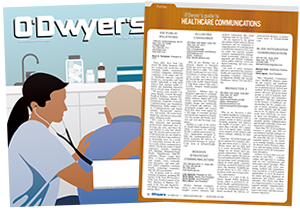 Stephanie DeViteri Stephanie DeViteri |
A continuous conversation among many of our agency’s pharmaceutical clients is whether to invest in unbranded campaigns. It’s not that they don’t see the value of providing general disease and related information, or even that the dollars don’t exist to fund it. It’s more a lack of confidence that they will be able to show senior management the impact of unbranded communications on a brand’s sales. Or, sometimes perceived as even worse, clients fear they may drive demand or sales for other products in their category, particularly if the client’s brand isn’t the market leaders.
|
|
Given this sentiment, it’s no surprise we continue to see a rise in branded DTC advertising. If you’ve watched real television lately — not the Netflix or DVR kind where you have the luxury of commercial-free options — chances are you’ve seen your fair share of drug ads for multiple treatments across a myriad of diseases. According to Nielsen research published in 2014, spending for direct-to-consumer ads increased by 21 percent over the prior year. Not surprisingly, DTC efforts continue to come under increased scrutiny among media as well as healthcare professionals, as evidenced by the American Medical Association proposing a complete ban of DTC advertising in late 2016.
The right time and place
I’m certainly not saying that DTC doesn’t hold an important place in the toolbox of marketing and communications professionals. However, unbranded initiatives, if done right, can successfully augment branded efforts and yield significant return for a brand and its company. Beyond just a sale, unbranded programming offers the potential to build brand loyalists and evangelists. And as budgets become tighter and critics become greater, finding alternate ways to reach consumers beyond a multi-million-dollar ad spend is a smart business move.
Ground rules for unbranded success
Here are five ground rules to help ensure an unbranded approach delivers on brand objectives.
Establish an online call-to-action with relevant digital resources. It goes without saying, an unbranded website is a perfect place to house disease and program information, particularly in a time when a majority of consumers are going online to find health information. And the information shouldn’t simply be static words on a page: mix up the content you’re serving your audience by using videos, animation, sharable images — like infographics — and other interactive materials that are easily accessible on your site while also shareable across social media platforms.
An additional benefit to launching a website: it serves as a way to measure the level and quality of engagement and interaction with your patient or caregiver community, such as how long visitors are spending on your site and what resources they are accessing. You may also consider housing polls or conducting push surveys that offer visitors an opportunity to weigh in on such questions as how they manage their condition, who they turn to for support and other topic areas. The insights you gather can help to inform how you evolve your programming and build out-patient resources from both a branded and unbranded perspective.
Encourage discussion with an expert, a.k.a., a certified medical professional. Beyond providing a robust website with relevant and engaging content, it’s imperative to encourage discussion with a doctor about symptoms and disease management, including treatment options. Help your audience to do this by providing a link to a local doctor finder (either embedded into the website or through a third-party patient advocacy group), providing discussion guides or sample questions to bring to their next appointment, and/or offering a free downloadable app where people can track important details of their condition and treatment plan on a smart phone or other device.
Make news media care about your initiative. With every unbranded program, and branded program for that matter, having the right spokespeople and purposeful rationale behind the timing of your program launch are critical components. For some programs, the right spokesperson is a real patient with an extraordinary testimony, a high-profile individual/celebrity, or a combination of the two, often in conjunction with a healthcare professional to lend medical credibility to the media pitch. Additionally, media want to know why your program should be prioritized among all of the other story leads crossing their desk or inbox. Ask yourself, what is driving the timing of your pitch — a seasonal connection, new research or disease report, an awareness or fundraising activity in which your spokesperson is participating? Be prepared to answer the “why now?” from reporters, and then once you have them hooked, make sure you have the right spokespeople to keep media’s interest.
Invest in paid search. We’ve had the privilege of partnering with brilliant digital and search strategists who have implemented strong paid search against our unbranded programs. I can’t say I’m an expert on the algorithms or terminology related to this expertise area, but I do know from experience — in most all cases — programs with a thoughtful paid search component outperform programs without one.
Drive leads for the brand. One of the clearest and most direct ways to connect an unbranded campaign to a brand is by encouraging website visitors to register, or “opt-in” to receive future branded communications from your company. This is often called a customer relationship management program or a lead generation database. While you’d have to partner with your regulatory colleagues to figure out the best way to do this for your company, it’s a tried and true concept that absolutely works. On average, we’ve seen our clients’ unbranded campaigns yield anywhere from a 10-30 percent opt-in rate of “qualified” brand leads. In one instance, shortly following the launch of a new, first-of-its-kind treatment for an inflammatory condition, one of the unbranded campaigns our agency launched in collaboration with a client became the second top driver of brand leads across all marketing efforts.
Beyond gathering registrations, linking directly to a brand’s website from the general treatment section of the unbranded program’s website is another good way to pull through leads to the brand; however, this isn’t always allowed by our clients’ regulatory teams.
The bottom line
Unbranded communications programs are not always an easy sell for sales-focused marketing leaders or in companies where there is no precedent for such a campaign. Yet, there is one common sense fact that is hard to argue: a person must first acknowledge they have a disease and how it may impact their life before they are empowered to speak with a doctor or consider a treatment plan … and it’s within this “moment of truth” where unbranded communications will thrive.
* * *
Stephanie DeViteri is Senior Vice President of Tonic Life Communications.



 Lo Isidro, senior director at Real Chemistry with more than a decade of strategic communications and PA experience, has joined Narrative Strategies.
Lo Isidro, senior director at Real Chemistry with more than a decade of strategic communications and PA experience, has joined Narrative Strategies. Nelson Fernandez, former North American chair of APCO Worldwide and managing director of Burson-Marsteller, has joined Volunteers in Medicine Berkshires as director of communications and PA.
Nelson Fernandez, former North American chair of APCO Worldwide and managing director of Burson-Marsteller, has joined Volunteers in Medicine Berkshires as director of communications and PA. Lilit Bargar, who was most recently an EVP in the healthcare practice at Weber Shandwick, comes on board at GCI Health as EVP, corporate practice lead.
Lilit Bargar, who was most recently an EVP in the healthcare practice at Weber Shandwick, comes on board at GCI Health as EVP, corporate practice lead.
 Five ways that successful thought leaders are made.
Five ways that successful thought leaders are made.


 Have a comment? Send it to
Have a comment? Send it to 
No comments have been submitted for this story yet.